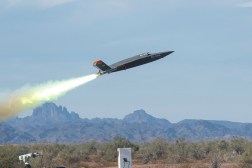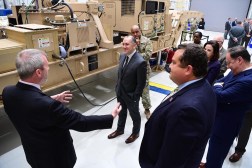Top Air Force general champions power of code during software factory visit

The chief of staff of the Air Force and other senior leaders paid a visit Tuesday to Kessel Run, the Air Force’s software factory and tech hub, where he underscored a commitment to a software-driven transformation of the department.
During his first visit to Kessel Run‘s Boston headquarters, Gen. Charles “CQ” Brown, the top officer in the Air Force, emphasized how he wants the Air Force to achieve some of its biggest modernization goals with rapid software developments. New programs at the heart of the Air Force’s evolution to a more digital branch will rely on software that is developed with the end-user in mind, Brown said during his visit to the coding factory. Kessel Run started as a pilot program for agile software development — where code is developed iteratively and refined to user needs — and has grown into a hub to rapidly and securely write and buy software for systems across the Air Force.
Brown has adopted a guiding mantra of “accelerate change or lose” as he leads the force. Much of that change will come from divesting from legacy platforms and dated aircraft programs in favor of modern software-defined platforms.
A big part of that, Brown said, is prioritizing the education of airmen on software development and using code as a tool to modernize systems in the fleet.
“Those are the areas that are going to be important,” he said during a Wednesday follow-up media roundtable in which he talked about the visit. “Someone is going to have to write code.”
Brown later added how he sees software as one of the most critical ways to evolve the Air Force’s current weapons systems and platforms. He pointed to the F-16 fighter jet — an aircraft that Brown himself has flown and even taught others to fly — as a system that can be transformed with more frequent software updates.
“The airplane actually changes because you are able to push more information to it,” he said.
Kessel Run helped develop programs that allow for more seamless software updates to the F-16, as opposed to a previous multi-day update process. Brown says that allows for the plane, and the force writ large, to be more nimble and invest more information from sensors.
“You are using software to change our approach,” he said.
JADC2 on the calendar
Software will also play a pivotal role in the Joint All Domain Command and Control (JADC2) operational concept: the futuristic strategy for defense driven by the coordination of an “internet of military things.” Brown told reporters Wednesday that he recently held talks on JADC2 with his counterpart in the Navy, Chief of Naval Operations Adm. Mike Gilday.
His discussions with Gilday come just before Lt. Gen. Dennis Crall, chief information officer of the Joint Staff, is set to hand over a document outlining the data standards and JADC2 strategy to the Chairman of the Joint Chiefs of Staff Gen. Mark Milley.
The Joint Staff is “laying out some level of standards and how we do data and digital architecture,” Brown told reporters. “That’s the lifeline.”
The Air Force has a memorandum of understanding with the Army to collaborate on JADC2 efforts, as the entire concept relies on sharing data across all domains and all services. Brown said he anticipates holding another meeting with Army Chief of Staff Gen. James McConville soon. Brown added that the publication of the DOD data strategy has helped increase collaboration.
“What we are seeing is a lot more dialog between the services,” Brown said.






